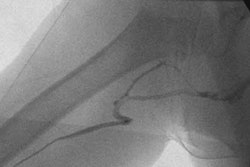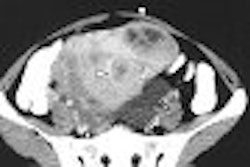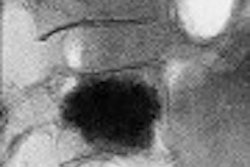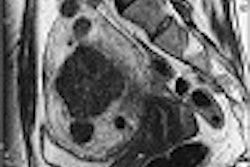SAN FRANCISCO - Assessing lung cancer patients with CT and PET may identify some mediastinal lymph node metastases reliably enough to jettison mediastinoscopy, according to a presentation Monday at the American Association for Thoracic Surgery (AATS) meeting.
"Treatment of non-small cell lung cancer (NSCLC) depends heavily on our ability to stage patients accurately," said Dr. Bryan Meyers from the department of surgery at Washington University in St. Louis. "There is general agreement that surgery alone for patients with metastases to the mediastinal lymph nodes, or N2 disease, is not sufficient therapy. There is current enthusiasm for induction therapy, and trials are in place to evaluate different induction therapy strategies in which N2 patients receive chemotherapy or chemoradiotherapy prior to surgery."
Meyers co-authors included Dr. Fabio Haddad, also from the university's department of surgery, and Dr. Barry Siegel from the Mallinckrodt Institute of Radiology at Washington University.
The three main modalities used for mediastinal lymph node staging are CT, PET, and mediastinoscopy. Each has its own problems, Meyers pointed out. CT lacks sensitivity and specificity; PET has better sensitivity and specificity, but a high false-positive rate.
"Mediastinoscopy is viewed as the gold standard, but it is an invasive surgical procedure that will add both cost and potential morbidity to the management of the lung cancer patient," Meyers explained. "This paper attempts to address the specific dilemma posed by a patient with known or suspected lung cancer who is stage I by both PET and CT. The question we are asking is whether mediastinoscopy should be routinely offered prior to resection, or whether the patient should go on to resection alone and be treated with (induction or adjuvant) therapy."
For this retrospective review, the authors mined their institution's thoracic surgery database between May 1999 and May 2004. Patients diagnosed with clinical stage I lung cancer by separate CT and PET exams were included. Using the data for the prevalence of mediastinal lymph node metastases, the researchers created a decision model. They also performed a sensitivity analysis of key variables.
The results showed that there were a total of 248 patients with clinical stage I lung cancer based on PET and CT. Of these, 72% underwent mediastinoscopy before resection and results were positive in 3%. An additional nine patients with N2 disease were found at thoracotomy for an overall prevalence of N2 disease of 5.6% (14 of 248). The sensitivity for mediastinoscopy was 38%.
They found that in patients with stage I lung cancer, if CT and PET scans did not indicate mediastinal lymph node metastasis, mediastinoscopy could be omitted. However, if PET or CT showed the possibility of mediastinal metastasis, confirmation by mediastinoscopy was necessary.
The decision analysis determined that CT and PET imaging were cheaper and more effective than routine mediastinoscopy.
"It shows that the 'no mediastinoscopy' approach resulted in an average survival of 7.28 years and an average cost per patient of $14, 800," Meyers stated. "The mediastinoscopy (approach) yielded a survival of 7.29 years and an average cost per patient of $16,800. The incremental effectiveness of the mediastinoscopy approach is 0.01 years, or less than four days. The incremental cost-effectiveness ratio is $207,000 per life year gained," he said.
When the prevalence of N2 disease exceeded 10%, the sensitivity analysis predicted that mediastinoscopy would lengthen life, but only at a cost-per-quality adjusted life year gained of more than $400,000.
"Mediastinoscopy is not a cost-effective addition to the workup of the patient who, on CT and PET, is T1 or T2 and N0," Meyers concluded. "Its routine use will add four days to the life of an average patient."
The group also concluded that the prevalence of N2 disease would have to be more than double the observed rates to make mediastinoscopy more effective than imaging. The current guidelines set forth by the American College of Chest Physicians recommend that mediastinoscopy be performed in all patients except those who have peripheral small (< 2 cm) tumors and no evidence of N2 disease on CT or PET imaging.
In an AATS invited commentary on this paper, Dr. Cameron Wright from Massachusetts General Hospital in Boston praised the group for offering evidence to back up current surgical practices.
"I believe the majority of U.S. surgeons go straight to resection if the patient is clinical stage I, based on CT and PET," Wright said. "I think the decision was based on old-fashioned clinical decision-making, knowing the low prevalence of occult N2 disease; the difficulty and nuisance of performing mediastinoscopy; the questionable benefit of induction therapy; and the expected favorable survival of occult N2 disease cases."
However, Wright did question the applicability of Meyers' results to all T2 tumors, pointing out that the prevalence of N2 disease increases with tumor size.
"My confidence in the upper end of T2 is not strong and that would be a particular group of patients where additional recruitment for a prospective trial might be beneficial," Meyers stated. In response to other audience member questions, Meyers also agreed that future studies should look at subtypes of metastases (adenocarcinoma, squamous) and location (central, peripheral).
"What we were trying to challenge (with this study) was the notion of routine mediastinoscopy, so we looked at all of the T1-T2 patients, or stage I patients," he said. "With more patients, you'd have the ability to parse it out so it would take (data) from more than one center."
By Shalmali Pal
AuntMinnie.com staff writer
April 11, 2005
Related Reading
Routine CT screening may not reduce mortality from lung cancer, May 24, 2005
PET/CT planning allows for greater gamble on NSCLC radiotherapy, March 16, 2005
Copyright © 2005 AuntMinnie.com



















